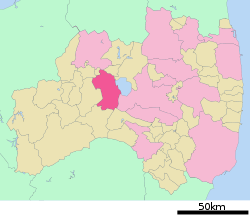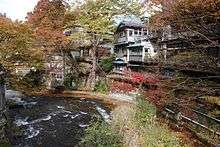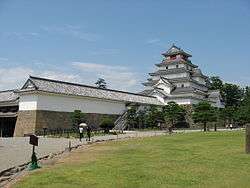Aizuwakamatsu
Aizuwakamatsu (会津若松市, Aizuwakamatsu-shi) is a city in Fukushima Prefecture, Japan. As of 1 March 2020, the city had an estimated population of 119,232 in 50,128 households,[1] and a population density of 310 persons per km2. The total area of the city was 382.97 square kilometres (147.87 sq mi).
Aizuwakamatsu 会津若松市 | |
|---|---|
 Aizuwakamatsu skyline | |
 Flag  Seal | |
 Location of Aizuwakamatsu in Fukushima Prefecture | |
 Aizuwakamatsu | |
| Coordinates: 37°29′41.4″N 139°55′47.1″E | |
| Country | Japan |
| Region | Tōhoku |
| Prefecture | Fukushima |
| Government | |
| • Mayor | Ichirō Kanke |
| Area | |
| • Total | 382.97 km2 (147.87 sq mi) |
| Population (March 1, 2020) | |
| • Total | 119,232 |
| • Density | 310/km2 (810/sq mi) |
| Time zone | UTC+9 (Japan Standard Time) |
| – Tree | Japanese Red Pine |
| – Flower | Common Hollyhock |
| – Bird | Common cuckoo |
| Phone number | 0242-39-1111 |
| Address | 3–46 Higashisakaemachi, Aizuwakamatsu-shi, Fukushima-ken 965-8601 |
| Website | Official website |

Geography

Aizuwakamatsu is located in the western part of Fukushima Prefecture, in the southeast part of Aizu basin.
Mountains
- Mount Ōtodake (1416 m)
- Mount Seaburi
- Mount Oda
- Mount Iimori
Rivers
- Aga River
- Nippashi River
- Yugawa River
- Sesenagi River
Lakes
- Lake Inawashiro
- Lake Wakasato
- Lake Higashiyama
- Lake Sohara
Hot springs
- Higashiyama Onsen
- Ashinomaki Onsen
Administrative divisions
There are 11 administrative divisions (hamlets or 大字 (ooaza)) in the city.[2]
- Wakamatsu
- Machikita
- Kouya
- Kouzashi
- Monden
- Ikki
- Higashiyama
- Ōto
- Minato
- Kitaaizu
- Kawahigashi
Demographics
Per Japanese census data,[3] the population of Aizuwakamatsu has not increased over the past 40 years.
| Year | Pop. | ±% |
|---|---|---|
| 1950 | 115,578 | — |
| 1960 | 119,402 | +3.3% |
| 1970 | 120,839 | +1.2% |
| 1980 | 130,883 | +8.3% |
| 1990 | 136,336 | +4.2% |
| 2000 | 135,415 | −0.7% |
| 2010 | 126,125 | −6.9% |
Climate
Aizuwakamatsu has a hot-summer Humid continental climate (Köppen Dfa) characterized by warm summers and cold winters with heavy snowfall. Although it is located in an inland valley, Aizuwakamatsu's climate resembles that of the Hokuriku region on the Sea of Japan coast. Snowfall is very heavy during the winter at 4.78 metres (190 in), and snow cover reaches an average maximum of 0.39 metres (15.35 in) and has reached as much as 1.15 metres (45.3 in) for short periods, a figure one would usually associate with much colder regions like the Labrador Peninsula. The average annual temperature in Aizuwakamatsu is 11.2 °C. The average annual rainfall is 1270 mm with September as the wettest month. The temperatures are highest on average in August, at around 24.7 °C, and lowest in January, at around -1.2 °C.[4]
| Climate data for Aizuwakamatsu, Fukushima (1981~2010) | |||||||||||||
|---|---|---|---|---|---|---|---|---|---|---|---|---|---|
| Month | Jan | Feb | Mar | Apr | May | Jun | Jul | Aug | Sep | Oct | Nov | Dec | Year |
| Record high °C (°F) | 13.1 (55.6) |
15.9 (60.6) |
22.8 (73.0) |
30.5 (86.9) |
33.3 (91.9) |
34.3 (93.7) |
36.7 (98.1) |
38.1 (100.6) |
35.4 (95.7) |
30.9 (87.6) |
24.5 (76.1) |
20.9 (69.6) |
38.1 (100.6) |
| Average high °C (°F) | 2.6 (36.7) |
3.6 (38.5) |
8.2 (46.8) |
16.4 (61.5) |
22.1 (71.8) |
25.4 (77.7) |
28.6 (83.5) |
30.6 (87.1) |
25.6 (78.1) |
19.0 (66.2) |
11.8 (53.2) |
5.7 (42.3) |
16.7 (62.1) |
| Average low °C (°F) | −3.7 (25.3) |
−3.6 (25.5) |
−1 (30) |
4.2 (39.6) |
10.0 (50.0) |
15.5 (59.9) |
19.5 (67.1) |
20.6 (69.1) |
16.3 (61.3) |
9.2 (48.6) |
3.1 (37.6) |
−0.9 (30.4) |
7.4 (45.3) |
| Record low °C (°F) | −14.4 (6.1) |
−15.2 (4.6) |
−11.9 (10.6) |
−4.6 (23.7) |
−1.2 (29.8) |
6.9 (44.4) |
9.1 (48.4) |
10.3 (50.5) |
4.8 (40.6) |
−1.5 (29.3) |
−5.9 (21.4) |
−14.4 (6.1) |
−15.2 (4.6) |
| Average precipitation mm (inches) | 95.3 (3.75) |
71.4 (2.81) |
71.7 (2.82) |
64.3 (2.53) |
80.0 (3.15) |
110.8 (4.36) |
175.8 (6.92) |
134.3 (5.29) |
136.9 (5.39) |
100.1 (3.94) |
78.9 (3.11) |
93.8 (3.69) |
1,213.3 (47.76) |
| Average snowfall cm (inches) | 171 (67) |
142 (56) |
66 (26) |
5 (2.0) |
0 (0) |
0 (0) |
0 (0) |
0 (0) |
0 (0) |
0 (0) |
6 (2.4) |
83 (33) |
473 (186.4) |
| Average precipitation days (≥ 0.5 mm) | 18.7 | 16.2 | 16.8 | 12.0 | 11.4 | 12.4 | 14.8 | 11.0 | 12.9 | 12.9 | 15.1 | 17.5 | 171.7 |
| Average snowy days | 27.0 | 24.3 | 12.3 | 0.8 | 0.0 | 0.0 | 0.0 | 0.0 | 0.0 | 0.0 | 1.0 | 12.4 | 77.8 |
| Average relative humidity (%) | 82 | 79 | 74 | 67 | 68 | 73 | 78 | 76 | 79 | 80 | 82 | 83 | 77 |
| Mean monthly sunshine hours | 78.5 | 98.8 | 138.2 | 172.7 | 193.6 | 161.9 | 159.8 | 198.7 | 132.1 | 121.1 | 86.8 | 70.7 | 1,612.9 |
| Source 1: Japan Meteorological Agency[5] | |||||||||||||
| Source 2: Japan Meteorological Agency (records)[6] | |||||||||||||
History
The area of present-day Aizuwakamatsu was part of ancient Mutsu Province, and was settled from prehistoric times. The Aizu-Otsuka Kofun within the city borders dates from the 4th century AD, and is an Important Cultural Property.
According to legend, in 88 BCE, Emperor Sujin sent two generals; Ohiko and Takenukawa-wake to the Tōhoku region for the purpose of establishing peace after the quashing of a rebellion in the region.[7]
Before the late 12th century, Aizuwakamatsu was mainly a market town and a base for regional warlords. Starting in 1192, Aizuwakamatsu became part of the regions that were controlled by the Kamakura shogunate. Soon after taking power, Yoritomo granted a samurai named Suwara Yoshitsura (from the Miura clan) all of Aizu. A descendant of Suwara, Ashina Morinori, began construction of the first castle in the city in 1384.[7] During the Sengoku period the final lord of Aizu, Ashina Moritaka, died in 1583 and soon the Ashina clan lost power. After the Satake clan took control of the castle, they placed a twelve-year-old member of their clan who was renamed Ashina Morishige and proclaimed lord of Aizu. The Ashina clan regained control of Aizu for a brief time in 1589 with the help of Date Masamune. However, Masamune took over the domain for himself soon after. He surrendered in 1590 to Toyotomi Hideyoshi. Toyotomi gave Aizu to one of his allies, Gamo Ujisato who then began construction in 1592 of a new castle at the site. It was during this time that the town was renamed "Wakamatsu" (young pine).[7]
During the Edo period, Aizu was controlled briefly by Uesugi Kagekatsu in 1600 after the death of Gamo Ujisato in 1596. Tokugawa Ieyasu accused Uesugi of gathering troops in Aizu. Ieyasu then transferred the Uesugi to Yonezawa. Through inheritance, Aizu was passed to Hoshina Masayuki (a brother of the third Tokugawa shogun) in 1643. The Edo period saw the economic and cultural growth of Aizu.[7]
Aizu Domain was the location of the Battle of Aizu, one of the largest conflicts of the Boshin War. After the Meiji Restoration, Wakamatsu Town was created with the establishment of the modern municipalities system on April 1, 1889. It became Wakamatsu City in 1899. On April 1, 1937, a part of Machikita village (from Kitaaizu District) was merged into the city of Wakamatsu. The remained was annexed on April 1, 1951. The name of the city was changed to Aizuwakamatsu on January 1, 1955 when Wakamatsu merged with seven villages of Kitaaizu District (Kouya, Kouzashi, Monden, Ikki, Higashiyama, Ōto and Minato). . A part of the town of Hongō (locality of Oya) (from Ōnuma District) was merged into Aizuwakamatsu on April 1, 1955.
Aizuwakamatsu further expanded by annexing the village of Kitaaizu (from Kitaaizu District) on November 1, 2004 and the town of Kawahigashi (from Kawanuma District) on November 1, 2005.
Government
Aizuwakamatsu has a mayor-council form of government with a directly elected mayor and a unicameral city legislature of 29 members[8] The city contributes four members to the Fukushima Prefectural Assembly. In terms of national politics, the city is part of Fukushima Electoral District 4 for the lower house of the Diet of Japan.
Economy
Aizuwakamatsu is a local commercial center. The area is traditionally noted for sake brewing and lacquerware. Modern industries include textiles, wood processing and electronics.[9]
Education
Aizuwakamatsu has one prefectural university and a private junior college. The city has 19 public elementary school and 11 public junior high schools operated by the city government. In addition, the is one private elementary school and one private junior high school. The Fukushima Prefectural Board of Education operates five public high schools and one combined junior/senior high school. The prefecture also operates two special education schools.
Universities and colleges
Senior high schools
Public (prefectural)
- Aizu High School (会津高等学校)
- Aoi High School (葵高等学校)
- Aizu Gakuhō High School (会津学鳳高等学校)
- Wakamatsu Shōgyō High School (若松商業高等学校)
- Aizu Kōgyō High School (若松工業高等学校)
- Aizu Second High School (会津第二高等学校)
Private
- Aizuwakamatsu Xaverio Gakuen High School (会津若松ザベリオ学園高等学校)
- Wakamatsu 1st High School (若松第一高等学校)
- Jinai High School (仁愛高等学校)
Junior high schools
Public (municipal)
- Aizuwakamatsu First Junior High School (会津若松市立第一中学校)
- Aizuwakamatsu Second Junior High School (会津若松市立第二中学校)
- Aizuwakamatsu Third Junior High School (会津若松市立第三中学校)
- Aizuwakamatsu Fourth Junior High School (会津若松市立第四中学校)
- Aizuwakamatsu Fifth Junior High School (会津若松市立第五中学校)
- Aizuwakamatsu Sixth Junior High School (会津若松市立第六中学校)
- Ikki Junior High School (一箕中学校)
- Ōto Junior High School (大戸中学校)
- Minato Junior High School (湊中学校)
- Kitaaizu Junior High School (北会津中学校)
- Kawahigashi Junior High School (河東中学校)
- Aizu Gakuhō Junior High School (会津学鳳中学校, prefectural)
- Note: All junior high schools are municipal except for Aizu Gakuhō Junior High School.
Private
- Aizuwakamatsu Xaverio Gakuen Junior High School (会津若松ザベリオ学園中学校)
Transportation
Railway
![]()
![]()
- Aizu-Wakamatsu – Nanukamachi – Nishi-Wakamatsu – Aizu-Hongō
- Nishi-Wakamatsu – Minami-Wakamatsu – Monden – Amaya – Ashinomaki-Onsen – Ōkawa-Dam-Kōen – Ashinomaki-Onsen-Minami
Highway
.png)






Media
Television
- NHK Fukushima
- Fukushima Television Broadcasting
- Fukushima Central Television
- Fukushima Broadcasting
- TV-U Fukushima
Newspapers
- Fukushima Mimpō
- Fukushima Min-Yū
Radio
- FM Aizu
Sister city relations
Japanese sister cities
- Mutsu, Aomori (Since September 23, 1984)
- Naruto, Tokushima (Since October 30, 1999)
- Ina, Nagano (Since September 24, 2000)
- Yokosuka, Kanagawa (Since April 17, 2005)
Local attractions

- Aizuwakamatsu Castle (Tsuruga-jo)
- Aizu Matsudaira's Royal Garden (Oyakuen)
- Mount Iimori
- Byakkotai graves
- Sazaedo
- former Takizawa Honjin
- Aizu Matsudaira clan grave
- Nisshinkan
- Aizu samurai houses
Culture
Festivals
- Aizu Festival
Others
Notable people from Aizuwakamatsu
- Sōichirō Hoshi, voice actor
- Hiroshi Sasagawa, anime creator
References
- Aizuwakamatsu city official statistics(in Japanese)
- 毎月大字別人口 Archived 2011-07-26 at the Wayback Machine (in Japanese)
- Aizuwakamatsu population statistics
- Aizuwakamatsu climate data
- "平年値(年・月ごとの値)". Japan Meteorological Agency. Retrieved 2011-11-26.
- "観測史上1~10位の値(年間を通じての値)". Japan Meteorological Agency. Retrieved 2011-11-26.
- Schellinger, Paul; Salkin, Robert, eds. (1996). International Dictionary of Historic Places, Volume 5: Asia and Oceania. Chicago: Fitzroy Dearborn Publishers. p. 10. ISBN 1-884964-04-4.
- Aizuwakamatsu city council home page Archived 2019-07-24 at the Wayback Machine(in Japanese)
- Campbell, Allen; Nobel, David S (1993). Japan: An Illustrated Encyclopedia. Kodansha. p. 24. ISBN 406205938X.
- "Hubei provincial government site". Archived from the original on 2016-03-04. Retrieved 2014-10-24.
External links
| Wikivoyage has a travel guide for Aizuwakamatsu. |
| Wikimedia Commons has media related to Aizuwakamatsu. |
- Official Website (in Japanese)